Archive for the ‘Card Games’ Category
August Through October FNM Promo’s Announced
Friday, August 1st, 2014
Check it out loyal Battleground Games & Hobbies fans! Wizards of the Coast announced last week the next few months of Friday Night Magic promo cards, including a couple of really cool cards, all featuring new art!
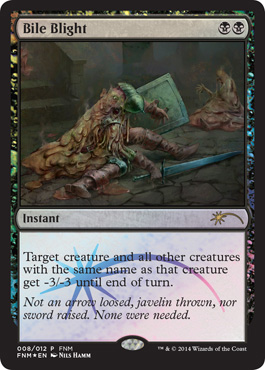
August 2014. Photo courtesy of Wizards of the Coast.
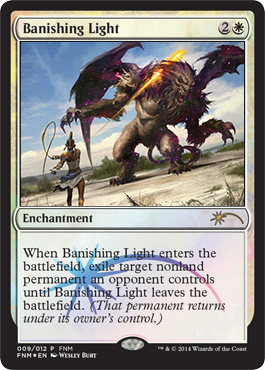
September 2014. Photo courtesy of Wizards of the Coast.
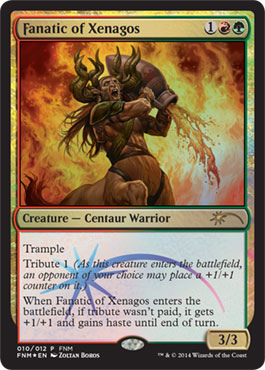
October 2014. Photo courtesy of Wizards of the Coast.
Remember, these awesome cards may only be earned at Friday Night Magic, so please don’t forget to join us at your local Battleground Games & Hobbies in Abington, MA or Plainville, MA!
What do you think of the upcoming exclusive promo cards? Let us know in the comments below!
Tags: Banishing Light, Bile Blight, Fanatic of Xenagos, FNM, Friday Night Magic, Magic the Gathering, MTG, Promo Cards, Wizards of the Coast
Posted in Blog, Card Games, Featured Post, Magic: The Gathering, Store Related | 1 Comment »
This week in Magic: Making Day 2 of GP Boston-Worcester
Thursday, July 31st, 2014
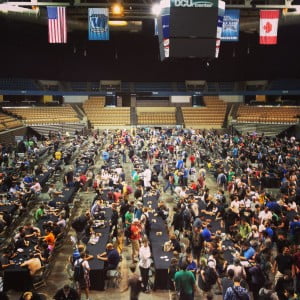
This past weekend was definitely a good weekend for me. In case you missed it, I made Day 2 of GP Boston-Worcester. It was so much of a surprise to myself that I was not at all prepared. I was such a mess that day, I didn’t even have a belt, and my pants were falling all day. Long story-short, I am in the middle of a move and my belt is in storage.
Not only was I missing a belt, but when I made Day 2 I was in scramble mode to find a place to sleep since my buddy Josh didn’t make it and wasn’t planning on driving into Worcester from the South Shore again. I was lucky enough to have a couple of offers to crash on the floor of friends’ hotel rooms. (Thanks to both Carl and Jason, by the way).
It should be no surprise what I played at the GP. If you’ve been following me for a while now, you’d know that I played Mono Red Burn. I went 7-2 on Day One, and unfortunately finished 2-3 on Day Two. While I missed out on cashing, I was just happy to make Day Two, as well as many of my other friends.
The journey to this point was not easy. I did a fair share of testing, and while testing, I got my fair share of stares and losses. There were times I felt defeated playing this deck. Day Two was never in my sights. I didn’t even pack a bag. Still, I managed to persevere. For your enjoyment, here is the list I ran:
Mono Red Burn aka 20 Mountains
Main Board:
4x Goblin Guide
4x Hellspark Elemental
4x Eidolon of the Great Revel
4x Lightning Bolt
4x Lava Spike
4x Shard Volley
4x Searing Blaze
4x Rift Bolt
4x Skull Crack
4x Flames of the Blood Hand
20x Mountain
Side Board:
3x Combust
2x Relic of Progenitus
2x Anger of the Gods
2x Molten Rain
3x Shattering Spree
3x Searing Blood
Hellspark Elemental was a last minute change over Spark Elemental. After some playtesting with my friend Jay, I had come to the conclusion that Spark Elemental was missing something. That something was being able to use itself over again. Hellspark Elemental’s ability to Unearth itself is huge. You’re essentially running eight of them.
I came across a nice variety of decks at the GP. In fact, during Day One, I played against two 8Rack decks. My two losses came against Merfolk and Fairies. I’ve never had a good run against Fairies, even when the deck was in Standard. I also did not test against it much outside of the tournament. My wins came against Jund, 2x 8Rack, 2x Scapeshift, GB, and UR Twin. Aside from the Twin match, the other decks were great opponents for me. As for my Twin matchup, he got land screwed game one, and then I just out burned him game two. He was gracious in his loss, and wished me luck after the match.
I should add that my two losses were within the first four rounds of the day. Thus, I had to win out the entire day. I definitely felt the heart palpitations coming on near the end of the final match. It went to third game, and thankfully I won it.
Day 2 was a little rough for me. Round one had me against my worst matchup in round one, Ad Nauseum. My only two wins came from another 8Rack match and a Jund match. The losses came from Ad Nauseum, Affinity (which was a heartbreaker for me), and Twin. Those last two losses were very close. Both my opponents let out big sighs of relief. Although, I’m not sure if it was because the matches were close, or they didn’t want to lose to Mono Red Burn. It could have been a combination of both.
Overall, I had a good time at the event. I mean, if you make Day 2, then there isn’t much to complain. Especially if you’ve never done it before. Sadly, I have been sick the past several years that a GP has been in the area – whether it was in Massachusetts or in Rhode Island. One year I made showed up on the second day of GP Boston the last time it was held in the Hynes Convention Center. However, I was so sick that day, I don’t remember much of it.
There were some things to be said about the GP on a finer level, but I’ll save that for another time.
Making changes to the deck
You already know I changed my Spark Elementals to Hellspark Elementals. There is very little I would change in the deck. If you’re looking for a very budget deck to run in Modern that has a good shot of winning a small sized tournament, this is your deck. If I were to run it in another major tournament, maybe something that is coming up in a couple of weeks, I would definitely throw in fetch lands. I would need to do more testing before I suggest running four or eight fetch lands, but, either way, they need to be run. The main reason: Searing Blaze.
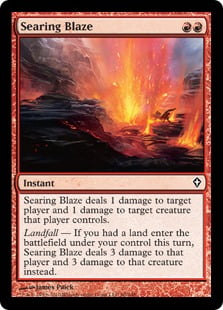
This card can really make or break the deck. Alone, it can be both the best card in the deck and it can be the absolute worse thing ever. It all depends on the landfall trigger. Even then, you can only cast this card on your turn. Thus, you’re never able to take full advantage of the spell. I’m sure if I had fetchlands in this deck, it would have run a lot more efficiently. I would have been able to thin the deck out and almost guaranteed I would have a way to trigger landfall.
In the end, the call is yours. Just remember it can mean the difference between a $50 deck and a $410 deck.
About the author
Simeon is now the Community Manager for Battleground Games & Hobbies. If you have any questions or inquiries, then you can reach him at Sims@battlegroundgames.com. He is also an avid gamer who loves to play board games and video games. He graduated college with a degree in Political Science, and now serves the public by writing about games. You can check that out here. Don’t forget to “like” him on Facebook as well. It’ll update you on all of his newest content. Best of all, you can follow Simeon on Twitter (@SimeonCortezano) for some real time hilarity. Thanks for reading!
Donate to the Extra-Life fundraiser!

Join the Battleground Games & Hobbies community forums!
Please don’t forget to check us out on Facebook and follow us on Twitter @battleground_gh!
Tags: gp boston-worcester, Magic the Gathering, Modern, MTG, Simeon Cortezano, Wizards of the Coast
Posted in Blog, Card Games, Events, Featured Author, Featured Post, Magic: The Gathering, Popular Posts | 3 Comments »
Wizards of the Coast Announces Sweeping Changes to ‘Magic’ Organized Play
Wednesday, July 30th, 2014
Wizards of the Coast announced yesterday sweeping changes to the Magic the Gathering organized play program as a result of unprecedented growth in both it’s Grand Prix program and Pro Tour Qualifier programs. Based upon feedback from the community at large, including judges, players, and local-game-store’s alike, the following changes were announced:
A New Path to the Pro Tour
The take away:
- New path to the Pro Tour will now feature a two-tier event series to qualify – a Preliminary PTQ feeding a Regional PTQ;
- Winners of Preliminary PTQ’s are invited to participate in the Regional PTQ;
- Preliminary PTQ’s will be run by local game stores;
- Qualified players may play in any Regional PTQ they wish;
- The top four finishers of the Regional PTQ qualify for the Pro Tour, including airfare;
- If a Regional PTQ has 128 participants or more, the top eight players qualify for the Pro Tour instead.
Improving Grand Prix Events
The take away:
- Amount of Grand Prix events increased from 46 to 54;
- The top eight (top four for a team event) will receive invitations to the Pro Tour regardless of event attendance;
- Everyone with 39 match points – or a record of 13-2 – will qualify for the Pro Tour;
- Total prize pay out increased to $70,000 if attendance is 3600 or more.
Changes to the Pro Player’s Club
The take away:
- Pro Points at Pro Tour’s will now be awarded based upon final match point score instead of final swiss standing beyond the top eight;
- Pro Points at Grand Prix events will likewise now be awarded based upon final match point score beyond the top eight;
- Players at the Pro Tour finishing with 33 match points or more will receive an invitation and airfare to the next Pro Tour;
- Minor changes to the threshold needed to reach Platinum Pro-level status;
- Gold Pro-level no longer awards a $500.00 appearance fee. Instead, Gold Pro-level now awards airfare to all Pro Tours for the season.
What do you think of these sweeping changes? Is this better for the Magic the Gathering organized play program or worse? Tell us what you think of the new changes effective beginning in August in the comments below!
Tags: Changes, Grand Prix, Magic the Gathering, MTG, Organized Play, Pro Tour, Pro Tour Qualifier, PTQ, Wizards of the Coast, WOTC
Posted in Blog, Card Games, Events, Featured Post, Magic: The Gathering, Popular Posts, Store Related | 1 Comment »
THE ‘MY LITTLE PONY’ CCG – AN UNEXPECTEDLY WELL MADE GAME by Derek Minasian
Tuesday, July 29th, 2014
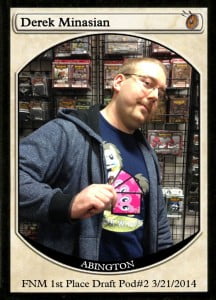
My name is Derek and this year I’ll be going on 33 years old. It is safe to say I’ve played “Magic: The Gathering” on and off for the better half my life. Nowadays I find myself just into limited formats and if you’ve ever seen me at the Battlegrounds in Abington at the “Friday Night Magic” draft you know for sure I am un-apologetically a Brony. If you haven’t heard the term before it is basically a catch-all for any adult fan of the TV series “My Little Pony: Friendship is Magic.” Now I’m not writing this to try to convince you to watch the show or to explain to you why I am a fan. Instead I want to tell you about the “My Little Pony CCG” released late 2013 published and released by Enterplay. Please don’t let the pink and purple pastel equines on the cards fool you. There is a real game in there and even I am surprised to say that it’s pretty good.
Before I get started I do want to address my obvious bias. I’ll probably tell you my morning coffee tastes better when I drink it from my Rainbow Dash mug and that I draft better when I have my Pinkie Pie play mat. These facts no doubt call my objectivity into question. To be honest with you when I heard there was going to be a “My Little Pony” TCG tie-in August of 2013 one could say I was cautiously optimistic at best. I didn’t really know what to expect from a company that had never made a card series like this before.
The premise
Unlike many TCG’s the “MLP CCG” is not so much about two players squaring off in a battle to defeat their opponent. The My Little Pony CCG actually focuses around the two players working together to solve various problems and thus advancing the game. Players earn points by solving these problems and the first player to score fifteen points is the winner.
The game mechanics are not terribly complex as it does, after all, need to appeal to a young audience. In my own experience I learned how to play inside the first round of the prerelease tournament using just my pre-made starter deck, a rule book, and the players sitting around me. What I have found fascinating is that despite the simple design of the game it has become quite competitive.
How it works
Each player needs a draw deck, a problem deck, and one main character of their choice. To those “M:TG” followers your main character is similar to having a commander in EDH. A player’s deck can use any combination of the game’s six colors or “elements” and like “M:TG” each color has its own unique style, key effects, and synergies.
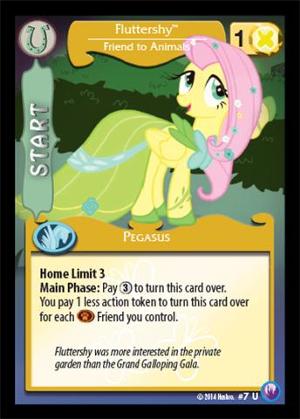
Main characters always begin in play and are the starting source of each player’s power or energy. Each main character is two-sided and has a unique flip condition. Once the condition is met the card becomes boosted and increases the main character’s power and typically grants new abilities. Main characters are always in play and can never be removed.
Problem decks must have exactly ten cards and are placed in the center of the play area with the top card face up. Each problem card displays its conditions for each player to solve.
The forty-five minimum card draw deck consists of your friends, resources, events, and troublemakers. These cards are used to solve problems or in some cases impair your opponents from solving them as well.
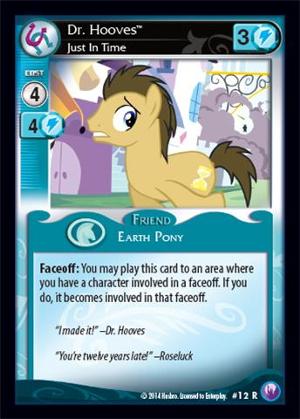
Similar to “M:TG,” each player’s turn is broken into phases. These phases are the ready phase, troublemaker phase, main phase, and score phase. Each player takes turns in an effort to solve the problem cards in order to achieve victory. Players earn action tokens each turn which can be spent or saved up to play cards.
But it’s for little girls
Well I certainly have heard that argument once or twice. There is no question that the TV show on which this game is based has drawn a much unexpected audience. I would argue as a gamer that the creators of the “MLP CCG” prioritized the strategy and game play mechanics to appeal to gamers before adding in the ponies.
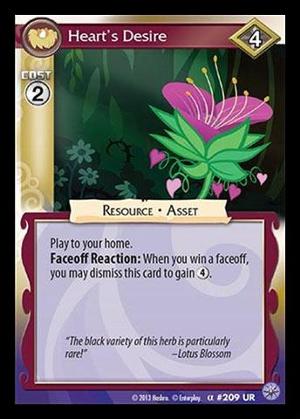
For the younger players the game’s mechanics allow for chance to be a large factor in deciding final outcomes. This allows casual players to have fun without having to rely heavily on the most powerful cards to win. For more serious competitors constructed decks are all about mitigating the game’s random effects, manipulating these effects, or outright overpowering them.
Like the TV show, the “MLP CCG” is also very meta with many pop culture references that would likely fly right over some of the little one’s heads. “M:TG” veterans like myself can and will find plenty of inside jokes referencing “M:TG” and other games that are hidden in the cards’ mechanics and flavor texts. In short the game is fun, family friendly, and suitable for ages ten and up.
In closing
I’m well aware a TCG or any game based on the “My Little Pony” franchise isn’t likely to have a broad spectrum appeal. I think it’s unfortunate that this well made, uniquely designed, and truly intuitive game might get looked over just because of the cutesy characters on the box. If you are however willing to check your hesitations at the door and give this game a try, you might be reminded that it isn’t the packaging or pictures in a game that make it great but the content of the game play that counts.
About the Author
Derek is one of the Abington store’s consistent FNM players. In person, he looks intimidating and hardcore. However, he gives great hugs and is very kind at heart. Don’t let his looks deceive you. While he may, admittedly, be a Brony, he is one of the strongest “Magic: The Gathering” Limited format players at the store.
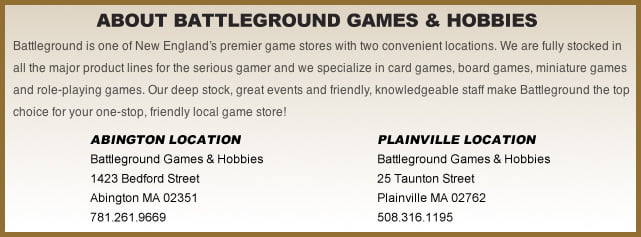
Join the Battleground Games & Hobbies community forums!
Please don’t forget to check us out on Facebook and follow us on Twitter @battleground_gh!
Tags: brony, CCG, derek minasian, mlp, my little pony, TCG
Posted in Blog, Card Games, Featured Author, Featured Post | No Comments »
‘Magic the Gathering’ at San Diego Comic Con
Tuesday, July 29th, 2014
Every year at San Diego Comic Con (SDCC), Wizards of the Coast always makes some amazing announcements for upcoming products. This year, they did not disappoint. Check it out!
Here’s some other sweet tidbits announced at SDCC:
From the Vault: Annihilation will be released August 22 and will include Armageddon, Wrath of God, Rolling Earthquake,Cataclysm, and Living Death.
Unknown products were announced too: The original four Duel Decks will be released as Duel Decks: Anthology. These were Jace vs. Chandra, Elves vs. Goblins, Divine vs. Demonic, and Garruk vs. Liliana.
Khans of Tarkir is going to be a large set—small set—large set block structure (like Innistrad, Dark Ascension, and Avacyn Restored, with a special consideration for Limited and “a time travel element” yet to be revealed.
Tarkir itself is a plane of five warring clans, each worships a different aspect of the plane’s (now extinct) dragons.
There will be more than just the clans on Tarkir: Djinn, Efreet, and Bears will be featured.
Seeded Prerelease boxes are returning, one for each clan, but this time the Prerelease promo for each will be one of eight different cards at random, easing some of the “one seeded box is much better for Limited than the others” concerns from recent prereleases, and hopefully resulting in more a even selection of boxes.
Finally, each clan will have its own mechanic, with morph returning for the block.
So, what do you think of this exciting announcement? What are you most excited about? Let us know in the comments below!
Tags: Commander, Duel Decks Speed Vs Cunning, From the Vault Annihilation, Khans of Tarkir, Magic Panel, Magic the Gathering, MTG, San Diego Comic Con, SDCC, Wizards of the Coal
Posted in Blog, Card Games, Featured Post, Magic: The Gathering, Popular Posts, Store Related | No Comments »
GP Boston-Worcester Top 32 Deck List: U/B Teachings by Carl Godon
Monday, July 28th, 2014
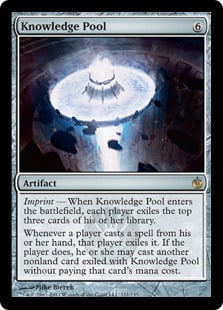
In case you missed it, GP Boston-Worcester came and went this past weekend. Several of our local players went on to make Day 2 of the event, including Nick Blake and myself. Carl is a local player who frequents the Abington store. He’s well know for his “unique and interesting” deck lists. So, it’s no surprise that people are wanting to know what he played this past weekend to a Top 32 finish at GP Boston-Worcester. It even peaked some interests when his deck got tweeted about. Here’s the list:
Creature:
3x Snapcaster Mage
2x Teferi, Mage of Zhalfir
1x Treasure Mage
1x Wurmcoil Engine
Sorcery:
3x Thoughtseize
2x Inquisition of Kozilek
1x Damnation
Instant:
1x Repeal
1x Smother
2x Disfigure
1x Hero’s Downfall
1x Darkblast
1x Mystical Teachings
2x Mana Leak
1x Consume the Meek
1x Slaughter Pact
1x Syncopate
2x Far//Away
3x Cryptic Command
2x Spell Snare
2x Think Twice
Artifact:
1x Knowledge Pool
Land:
1x Misty Rainforest
2x Scalding Tarn
3x Tectonic Edge
2x Dreadship Reef
2x Snow-Covered Swamp
4x Snow-Covered Island
4x Watery Grave
4x Creeping Tar Pit
2x Dark Slick Shores
1x Urborg, Tomb of Yawgmoth
Sideboard:
1x Devour Flesh
3x Pack Rat
1x Duress
1x Tectonic Edge
1x Thoughtseize
1x Mindbreak Trap
1x Grafdigger’s Cage
2x Shadow of Doubt
2x Threads of Disloyalty
1x Damping Matrix
1x Ashiok, Nightmare Weaver
That’s a lot of one-ofs and two-ofs, but it definitely looks like a “Carl” deck as we like to say. The most interesting part of the deck is Knowledge Pool, and, yes, you’re reading the deck list correctly. There is only one copy in the deck. Some of you who follow Jackie Lee on Twitter may have seen her post about how her “opponent casually” locked her out of the game with Knowledge Pool.
Opponent casually comboed me out with Teferi/Knowledge Pool. No big. 11-4 #GPBoston
— Jackie Lee (@JackieL33) July 27, 2014
The obvious question people had was, “What’s Knowledge Pool?” The next question was how Carl locked people out of the game with the card. The short version of the card is this: when the card is played, both players must exile the top three cards of their library. This is through the card’s “Imprint” mechanic. The card goes on to say that, now, whenever a player plays a spell, that spell is exiled. If the player exiles the card, they can cast any card that was originally exiled by Knowledge Pool and play it without paying it’s casting cost.
Sounds great, right? Well not if Teferi is in play. Confused? It’s okay. We all are. The lock is so obscure, I even had trouble forming words to explain it. Here is the best explanation thanks to the internet. “Knowledge Pool’s triggered ability is on the stack at the time they could cast an exiled spell from it, as the stack is not empty, that player could not cast a sorcery at this time. Thus they cannot cast any spells at this time due to Teferi’s effect, meaning knowledge pool exiles any spell not cast from hand without any return for opponents. So they only spells they cast not from hand (flashback for instance or via madness) can resolve and also land drops are unaffected.”
The strategy actually originates from EDH. This was one of the most interesting facts I found out while researching about the lock.
Well that’s it for now. I’ll be writing about my own experiences from this past weekend’s events, and, if you’re lucky, maybe we’ll even get Nick to talk about his time at the event as well.


Tags: carl godon, gp boston, Magic the Gathering, MTG, teachings, Wizards of the Coast, worcester
Posted in Blog, Card Games, Events, Featured Post, Magic: The Gathering, Popular Posts, Store Related | No Comments »
Email Us
abington@battlegroundgames.com
norton@battlegroundgames.com
saugus@battlegroundgames.com
framingham@battlegroundgames.com
Archives
- October 2025
- September 2025
- June 2025
- May 2025
- March 2025
- November 2024
- October 2024
- September 2024
- February 2024
- October 2023
- June 2023
- January 2023
Categories
- Products
- Buylist
- Policies
- Contact Us

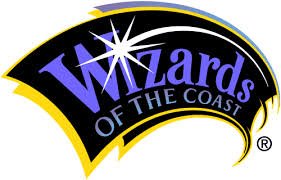

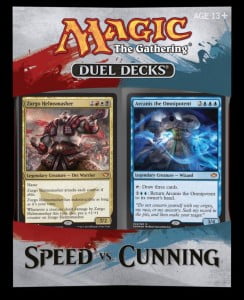
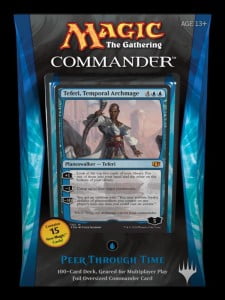
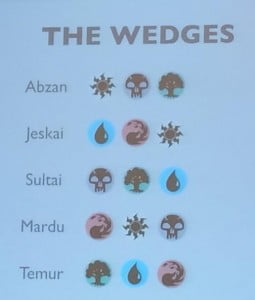


Social: